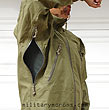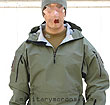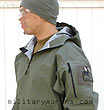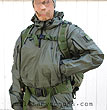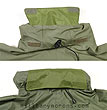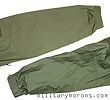As a sizing reference: I'm 5'7", 155 lbs (yeah, I'm a little guy), medium build (BDU top medium/regular, BDU pant medium/short), waist 32", chest 43". Keep this in mind when you read my comments with respect to sizing, so you have an idea of how the garments featured below will fit on you. ALL garments in these pages are size Medium, unless stated otherwise.
TO VIEW FULL SIZE IMAGES: USERNAME and PASSWORD are both "mm"
| 5/20/07 - I met Todd Fairbairn of Ops-Technical Gear at the 2005 SHOT Show. He had some interesting stuff on display - softshells, hardshells etc. At the 2006 SHOT Show, he was sporting a MultiCam hardshell that everyone was drooling over. Since then, he has renamed the company OTTE Gear. 'Otte' was Todd's grandfather's last name. Todd chose to honour his grandfather (who was a soldier, and had no sons) and keep his name alive by naming his company after him. OTTE gear's goal is to provide lightweight, packable and durable clothing for troops and civilians alike for harsh use. Featured here is OTTE Gear's Patrol Parka, in Crye MultiCam. A matching hardshell pant is also available. Material - A note about hardshell MultiCam material. Ever since Crye Precision introduced the MultiCam pattern, we've been waiting for Gore to produce MultiCam GoreTex fabric, or an equivalent hardshell material. However, that project has yet to come to fruition. Crye does not (at the time of this writing), and has not, produced or marketed waterproof hardshell fabric for production use. Bradford Dye, who produces some of the MultiCam fabric for Crye, has printed small quantities of 70D taslan nylon. While the 70D fabric has not yet been tested and officially approved by Crye for its IR properties, Bradford does use the correct dyes to the IR spec. It is this 70D nylon that OTTE purchased and laminated to produce 3-layer hardshell material. The fabric shown is MultiCam 70D Taslan nylon laminated to a PU (Polyurethane) film, as opposed to PTFE film, with a DWR finish on the face . The result is a waterproof/breathable 3-layer fabric very similar in look and feel to GoreTex XCR, but with a slightly softer hand. OTTE Gear will also be experimenting with some PTFE films as well. PU film laminates are in wide use by the outdoor gear industry. Here's a summary of the features on the Patrol Parka Hardshell:
Sizing - I got the Medium size, and there's more than enough room to wear the Patrol Parka over insulated layers. It'll fit over the bulky SPEAR fleece jacket without a problem. There's enough length and room for full mobility and range of motion without the jacket or sleeves riding up, but it doesn't feel or look oversized when worn by itself. As far as 'breathability' goes, I found the Patrol Parka one of the more comfortable, less 'stuffy'-feeling hard shells. Also, while the fabric doesn't seem any thinner than XCR, it's not as stiff. It's my guess that the Patrol Parka can be used in slightly warmer temperatures or climates than garments made out of Goretex XCR or classic. This review will be updated when I get some rain. Updated 8/26/07 - Just got the first rain of the season - we had light to medium rain and it was a bit muggy, but I spent about an hour walking around the neighbourhood with the Patrol Parka. It kept me completely dry underneath, as expected, but the thing that struck me most was the comfort. Usually it feels a bit humid under rain gear but the OTTE Patrol Parka didn't feel stuffy at all. I'd have to rate this as the most 'breathable' hardshell jacket I've tried so far. Very promising. Updated 1/06/08 - I tested it out in very heavy rain the day before, and also at the range the next day. It performed admirably in the rain - no wet throughs or anything. The next days was damp, and the temperature was around 60°. Running around, it got a bit warm and stuffy, but this was even without a jacket. When the temp got a bit colder, it was very comfortable and more importantly kept me dry from the wet ground when shooting from prone. |
OTTE Gear Patrol Parka (Earth)
| 11/15/07 - Here's a look at OTTE Gear's Hardline Patrol Parka in Earth Colour. It differs from the MultiCam Patrol Parka above in both material and of course, colour. All other features and dimensions are the same. Material - During the time the MultiCam Patrol Parka was reviewed, OTTE Gear was experimenting with PTFE membranes besides the PU membrane that was featured above. Since then, OTTE has chosen Donaldson Tetratex® PTFE laminate for all their Patrol Parkas. Donaldson’s PTFE laminate is found in current Military waterproof breathable jackets. It is beefier and slightly more durable than the PU film laminate used on the MC Parka, but slightly stiffer. That was the first thing I noticed when I handled the Earth Patrol Parka. According to OTTE, It was a trade off, but some of the operators in the field wanted the beefier fabric for when they are rolling around on the rocky ground. It will perform like classic Gore-tex; not quite as breathable as Gore-Tex XCR but many users probably won't notice the difference. Donaldson also puts a thicker coating of DWR (Durable Water Repellant) on the fabric that softens up with use. For detailed features of the Patrol Parka (Earth) Hardshell, please see the above review of the MultiCam Patrol Parka.
The "Earth" colour is a bit difficult to pin down; the shade is a bit more on the green side than brown, sort of like Eagle's khaki, but not as yellow. It goes well with most nylon gear, as seen above with an OD MAXPEDITION mini rollypoly, an EMDOM MultiCam Recon Waist Pack, and BH camel tan (khaki) pouch. It goes particularly well with Crye MultiCam as it matches some of the shades in MC very closely. As far as the inital 'stiffness' of the material, Todd was correct - it softens up with wear. Because the material is beefier than the MC PU material, this parka can be used in cooler/colder temperatures that Gore-Tex "classic" garments would be used in. |
| 4/25/10 - The OTTE Gear Patrol Parka is designed for the operator who spends extended time in the field where weight, durability and complete weather protection are mission-critical factors. I first featured the OTTE Gear Patrol Parka back in 2007. Since then, the Patrol Parka has undergone some changes, which were implemented in the fall of 2009. The changes are in both design and manufacturing; resulting in a more refined and improved product. OTTE Gear was one of the first companies to debut a hard shell jacket in Crye MultiCam. One of the challenges back then was finding hard shell fabric in MultiCam. Back in 2007, since a water proof breathable fabric was not yet available in MultiCam, companies had to purchase 70D taslan nylon fabric and laminate it to produce 3-layer hardshell material. The original OTTE Patrol Parka was made from this 70D taslan nylon laminated to a PU (Polyurethant) fil with a DWR finish. Since then, Crye has introduced a much wider variety of MultiCam fabrics through Duro Industries, including a waterproof breathable. The 'Gen 2' Patrol Parka is made from this material. I'll refer to this as the 'Gen 2' to differentiate it from the previous 'Gen 1' version reviewed above, to which I'll be comparing it to, since that's my frame of reference. The Gen 2 Patrol Parka is now made in Canada, vs. China for some of the earlier versions. This has enabled OTTE to take advantage of some of the more advanced manufacturing and construction capabilities available in Canada. Here's a summary of the features on the Gen 2 Patrol Parka Hardshell. The overall design is shared with the Gen 1 parka, but with some major detail differences in the construction:
Sizing - The Gen 2 is sized the same as the Gen 1 as far as I can tell. I have the Medium size, and there's more than enough room to wear it over insulated layers. There's enough length and room for full mobility and range of motion without the jacket or sleeves riding up, but it doesn't feel or look oversized when worn by itself. Note/Observations - I got this in early March when we had some unusually rainy weather, so I took advantage of it whenever I could to try out my weather-resistant gear. The Patrol Parka performed as expected, based on my earlier observations with the fabric. The DWR was better than on the Gen 1, which meant that water rolled off better and the outer fabric didn't get saturated. No water made it through at all; I'd have been very surprised if any had. The only minor thing I noticed was the water rolling down the back of the hood can collect and drip into the hood compartment in the collar (note that the compartment is waterproof and the user will still remain dry). Some water will drain out the shock cord grommet at the bottom, but if there's water in the collar, it can still wet the inside of the hood when the jacket is taken off or when the hood is flipped down. Only a little bit made it in when I used it in heavy rain, but it's still something for OTTE to look at for future tweaks, as other users might be using it under wetter conditions for extended periods. As with the Gen 1 Patrol Parka, the Gen 2 felt very breathable for a hard shell and didn't get overly stuffy. Being slightly heavier, the fabric is a bit stiffer than some lighter weight hard shell fabrics like eVent, or Gore-Tex XCR, but still much better than Gore-Tex classic. Stiffer also conveys a sense of additional durability. With some of the earlier OTTE products, I felt that some of the stitching could be tighter, and there was some catching up to do when compared with Arc'teryx (which I usually use as the standard as far as "state of the art" and technology goes). With the use of welded construction and top-stitchless seams, OTTE has made a leap forward with the Gen 2 Patrol Parka.
|
TAD Gear Combat and Bug Out Anorak Hardshells (discontinued)
| 4/23/08 - Triple Aught Design (TAD Gear) has introduced two new hardshell jackets, the Combat Anorak and Bug Out Anorak Hardshells. The Combat Anorak was designed to be the most abrasion-resistant hardshell available, that would stand up to just about anything you could throw at it. The Bug Out Anorak was designed to provide protection from the elements in a more compactable package for stowing. They're essentially Anorak versions of the Predator Hardshell, and share many of the same features. An Anorak is typically described as a hooded pullover garment instead of having a full front zipper. I used to wear them when I was a kid in England. The word 'Anorak' has its origins in Eskimo-Aleut language. Now, why offer an Anorak design? I asked Patrick at TAD to shed some light on this latest direction in TAD's hardshell offerings and he replied: "The traditional reasoning behind an anorak versus full zips were that anoraks are typically to be worn for long periods of time and would provide the user with better overall protection by virtue of “less zipper”. This translated to “fewer possible points of entry for snow, wind and rain”. Also, less zipper = less weight/bulk. Without a full zipper, there are no hot spots and friction points on the body when wearing a pack waist belt. In fact some old classic designs had the Kangaroo pocket big enough to allow the belt to pass entirely thru on the inside. The Kangaroo pocket also allowed for both hands to be put together to keep warm. In high altitude alpine conditions, a shell would be worn all day; mountaineering, skiing, etc. Professional dogsledders, European mountain/ski troops, arctic explorers still use the anorak design. The TAD Combat anorak design is tasked for those kinds of environments where a shell would be worn all day, into the night and possible even to sleep. The Kevlar blend poly 3 layer found in the combat anorak IS the most abrasion resistant shell available from anyone, it is a tough mofo of a shell. The fabric was developed specifically to resist frequent exposure to rock faces, crampons, ski edges, and “climbing racks” (pitons, anchors such as cams, etc found on a sling). The Bug Out Anorak was a shell I wanted to offer that had less bulk and was more compactable for stowing. All of TAD's hardshells are great overall shells for protection against rain, snow, wind. However each has it’s own specialty and excels in that specialty. Anorak designs are a bit of a throwback, as there is the very compelling convenience of easy on/off with full zip jackets which dominate the market today. But, the virtues of an anorak stand out under certain circumstances, and are enough for me to explore the design this year." So, there you have it from Mr. TAD himself. Other than some small details, the main difference between the Combat and Bug Out Anoraks is the material. Material - The TAD Gear Combat Anorak is constructed of TAD's "Storm Shield EDGE" 3 layer, waterproof/windproof/breathable Kevlar reinforced shell fabric. Going beyond TAD's regular Storm Shield 3 layer fabric, the EDGE version of their high performance, technical material has all the familiar well known benefits of a waterproof-breathable textile, but now has the highest abrasion resistance of any hardshell available on the market, anywhere. Storm Shield EDGE is designed to provide extra protection against the environment, tools and equipment commonly found in alpine and mountaineering arenas that can wreak havoc on typical hardshells. The Combat Anorak is currrently only available in TAD's M.E. (Multi Environment) Green. The shade of green is slightly more olive/darker than either the Predator V1.0 or the Bug Out Anorak. It doesn't have the typical nylon look or feel to it; in fact it reminds me of the oiled canvas Drover coats, only without the oily sheen or feel. It's slightly stiffer than the Predator.
The TAD Gear Bug Out Anorak is constructed out of TADs durable, all-season, light weight "Storm Shield LITE", which is a 3 layer, waterproof/windproof/breathable ripstop nylon shell fabric. Like the EDGE fabric of the Combat Anorak, the Storm Shield LITE version has all the benefits of a waterproof-breathable textile, but is made in a lighter weight modified ripstop pattern. It's probably one of the lightest 3-layer hardshell fabrics I've come across. It is designed to be "durable enough for fast summit assaults to summer thunderheads" and protect the wearer from the elements, but with reduced weight, bulk, and packs down to a compact and portable size. The Bug Out Anorak is also available only in M.E. Green for now. The fabric isn't a solid green colour; there's a pleasing subdued crosshatch pattern to it, with the horizontal lines fainter than the vertical ones. Overall Features The Combat and Bug Out Anoraks share the same features except for the material; the other main difference is that the Combat Anorak has a traditional length bias Alpine cut and is about 2.5" longer than the Bug Out Anorak (which has a modern length bias Alpine cut) in the front and back, and about 3" longer than the Predator so it's more of a traditional length anorak. This is so it covers the loins better when sitting down and much of the seat. The Combat Anorak and Bug Out Anorak have the same overall
fit and cut. In the photos below, the Combat Anorak looks a bit bigger,
but it's due to the stiffness of the fabric. The Bug Out Anorak is
thinner and tends to drape more over the body.
Notes about fit - When you're considering one of these Anoraks vs. a regular full zip jacket like the Predator Hard Shell, the key questions I'd ask are 'what are you going to use it for?' and 'are you planning on wearing it over bulky layers?'. The trade-off for some weight savings and less of an opening to moisture or dirt is on/off convenience. If you're planning on taking it on and off frequently, then a full zip front jacket has the advantage. Wearing anything on your head won't help with the donning or doffing process. I'f you've got a helmet, that probably has to come off. Also, if you're planning on using it as a shell over bulky layers, bear in mind that an Anorak will be more difficult to don and doff. How easy it is to put on and take off depends on how you fit into the Anorak. I'm a medium build and wear a medium Anorak. If I were any bulkier or my shoulders much broader, I'd have some difficulty putting it on, and would probably have to go up a size. Just to try it out, I tried to put on the Combat Anorak over the Ranger Hoodie, which is quick fleece. Much to my wife's amusement, it took me a bit of struggling to get it over my head and shoulders, as the Anorak doesn't stretch. Once I got it on, there was ample room inside the Anorak to accomodate the Ranger Hoodie, but it wasn't easy to put on over it. I had no problems putting both Anoraks over a thinner layer like a sweatshirt. If you have a Predator or similar jacket, leave the front zipped up and see if you can easily put it on my slipping it over your head and shoulders, to get an idea of how the Anoraks might fit over insulative clothing. The Bug Out Anorak is a bit easier to don and doff as the material isn't as stiff as the Combat Anorak and it has a bit of 'give' to it. General Notes - I've worn both in the rain, and they kept me dry, as expected. I was actually surprised how non-stuffy the Combat Anorak feels. Before putting it on, and based on how the material felt, I thought it'd get too hot and stuffy unless it was really chilly, but that wasn't the case. I felt comfortable wearing the Combat Anorak in temperatures where I'd be uncomfortable in my original Goretex Gen I ECWCS parka (upper 60's). The Bug Out Anorak can be used in warmer weather than the Combat Anorak; comfortable up through the mid-70's. TAD designed the Combat Anorak to be "one of the toughest, most abrasion resistant jackets anywhere; a dedicated service hardshell specifically tasked for alpine and mountain environments". The Kevlar reinforced material sure feels tough and is substantial enough to provide some protection against scrapes and knocks, and makes it more comfortable on your elbows and front when in the prone position on uneven ground with stones or little rocks. If you're going to be scrambling around rocks or spending time on your belly in the prone position and you know you're going to be in inclement weather, the Combat Anorak would be the one to get. If you don't need the extra abrasion resistance, and want a lighter weight specialized hardshell that's easier to compress and pack, then the Bug Out would be a good choice. It functions great as a wind or rain shirt over other clothing and it's light enough to carry in a pack, car or bag 'just in case', even if you're not sure it's going to rain.
|
ATTENTION! PLEASE DO NOT LINK DIRECTLY TO MY IMAGES
-
IT RESULTS IN MY BANDWIDTH ALLOCATIONS BEING EXCEEDED,
AND MY PAGES GO DOWN. THANKS!
/ . PLEASE
OBSERVE AND RESPECT OUR COPYRIGHT! . /
©opyright by MilitaryMorons.com. All Rights Reserved. Reproduction, Duplication,
Distribution Strictly Prohibited.
Unless mentioned otherwise, content and images are the
property of militarymorons.com and are not in the public domain.
They are not to be used without
permission. Please Contact
me for permission to use any images or content herein.























